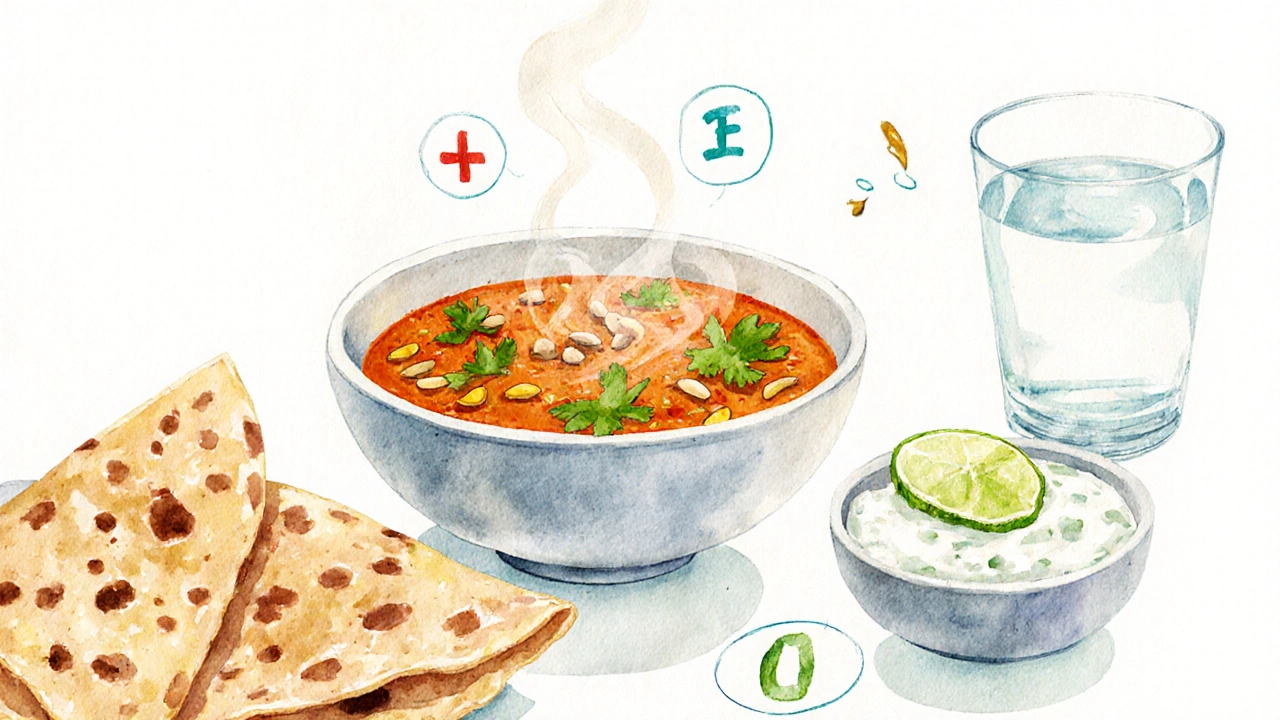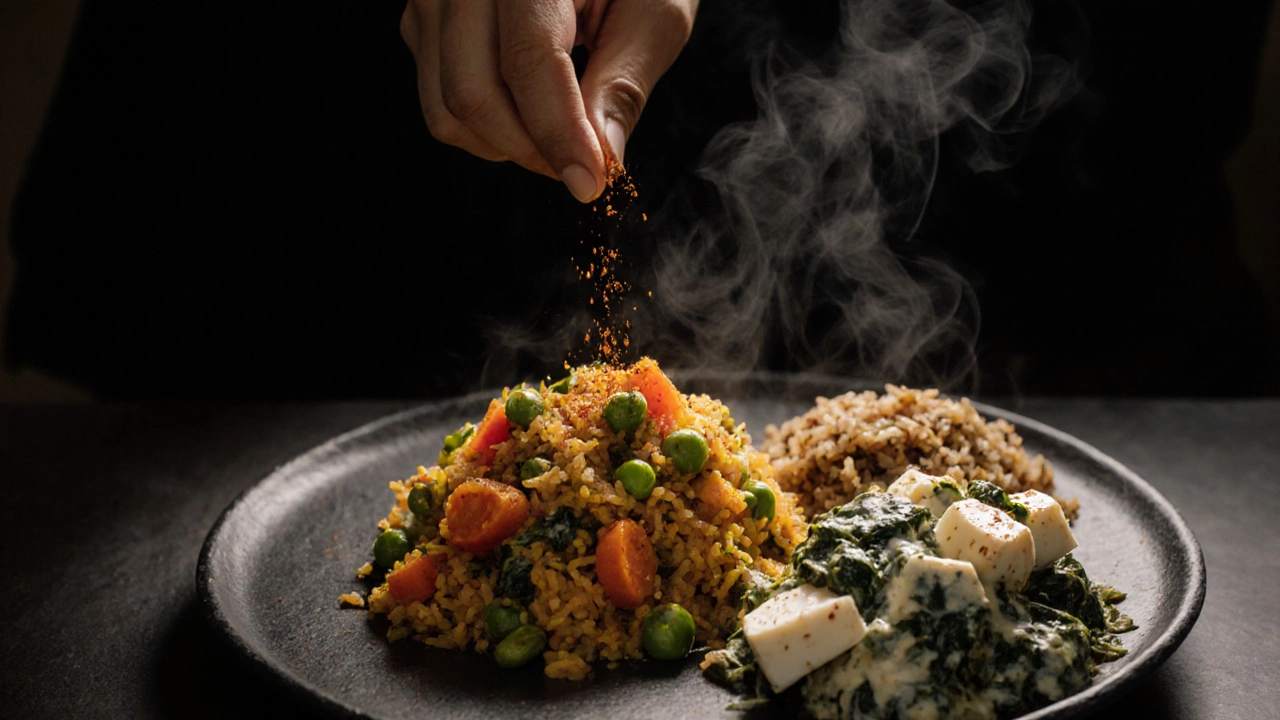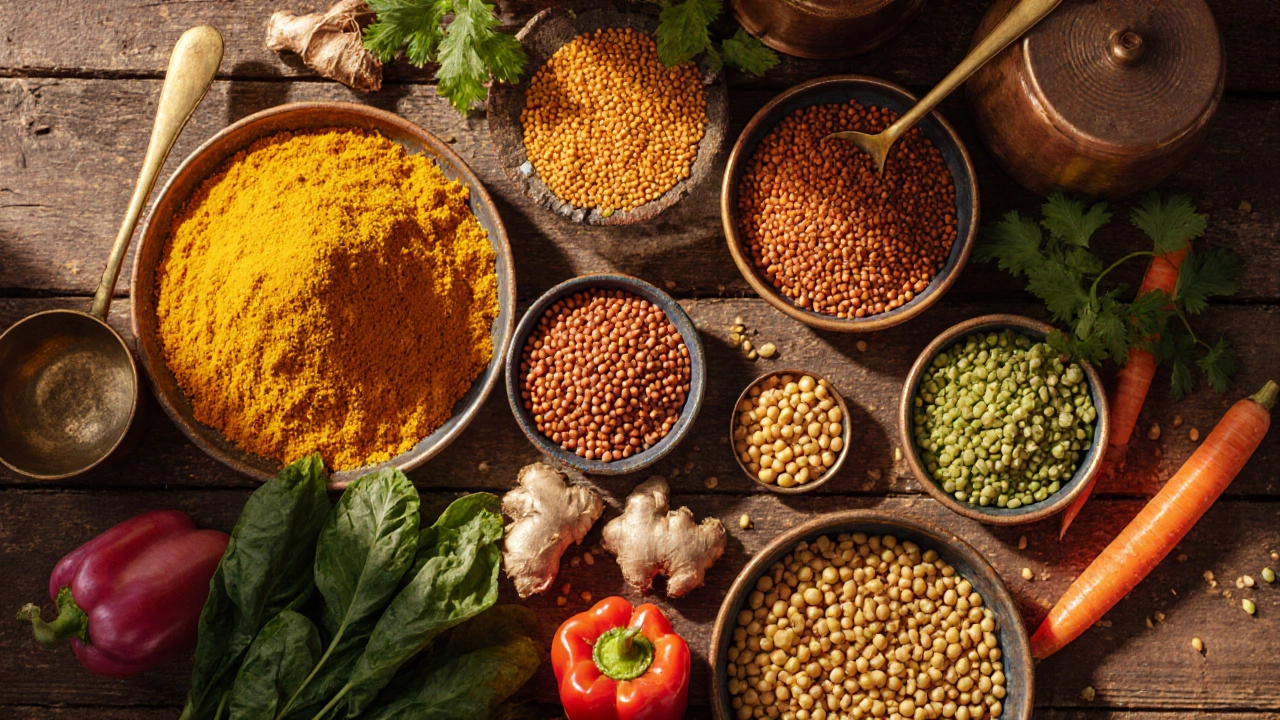Indian Meal Nutrition Calculator
Select Dish
Nutrition Results
Select a dish and click Calculate to see nutrition details
You might picture Indian food as a plate piled with buttery naan and a mountain of deep‑fried samosas, but the reality is far richer - and often a lot healthier than you think. Indian cuisine is a diverse culinary tradition from the Indian subcontinent that blends spices, vegetables, legumes, and grains, offering a pantry of nutrients that can support heart health, digestion, and even mood.
Why Indian Food Stands Out Nutritionally
At its core, Indian cooking relies heavily on plant‑based ingredients. Lentils, chickpeas, beans, and a rainbow of vegetables make up the bulk of everyday meals. These foods are naturally high in fiber, protein, and essential micronutrients like iron and folate. When you pair them with spices such as turmeric, cumin, and ginger, you add anti‑inflammatory and antioxidant powerhouses to the mix.
But not every Indian dish is created equal. The cooking oil, portion size, and dairy choices can swing a plate from heart‑healthy to calorie‑dense in minutes. Understanding these variables is the key to turning Indian meals into truly healthy Indian food.
Key Ingredients and Their Health Benefits
- Turmeric contains curcumin, a compound linked to reduced inflammation and improved joint health
- Cumin offers antioxidant properties and may aid in digestion by stimulating gastric enzymes
- Ginger helps regulate blood sugar and eases nausea, making it a common remedy in Ayurvedic practices
- Ghee clarified butter that, when used in moderation, provides fat‑soluble vitamins A, D, E, and K
- Lentils are a staple protein source with about 18g of protein and 15g of fiber per cooked cup
- Chickpeas deliver steady energy thanks to low‑glycemic carbs and also contain antioxidants like quercetin
Typical Vegetarian Indian Dishes and Their Nutrition
Below are five popular vegetarian dishes, each broken down by its main nutrients. All portions are based on a standard home‑cooked serving (about one cup).
- Dal Tadka: Made from split yellow lentils, this stew provides ~200kcal, 12g protein, 8g fiber, and a healthy dose of potassium.
- Chana Masala: Chickpeas simmered in tomato‑onion gravy deliver ~250kcal, 14g protein, 10g fiber, and plenty of iron.
- Palak Paneer: Spinach blended with cubes of paneer (Indian cheese) offers ~300kcal, 15g protein, 4g fiber, and calcium from the cheese.
- Vegetable Biryani: A fragrant rice dish mixed with carrots, peas, and beans. It totals ~350kcal, 7g protein, 6g fiber, and a burst of vitamin A from carrots.
- Masoor Dal (Red Lentil Soup): Very quick to cook, it yields ~180kcal, 13g protein, 9g fiber, and folate.
Notice the common thread: high protein, generous fiber, and a spectrum of micronutrients. When you pair these dishes with a side of whole‑grain roti or brown rice, you create a balanced plate that aligns well with dietary guidelines.

Common Pitfalls and How to Tweak Them
Even the healthiest dishes can become calorie‑laden if you’re not careful. Here’s what to watch out for and quick fixes:
- Excessive Ghee or Oil: A tablespoon adds ~120kcal. Use a non‑stick pan and limit oil to 1‑2 teaspoons per dish. Substitute with a splash of water or vegetable broth for sautéing.
- Deep‑Fried Snacks: Pakoras, bhajis, and samosas are delicious but soak up oil. Bake them at 200°C for 20‑25minutes, or air‑fry for a crisp texture with 60% fewer calories.
- Heavy Cream or Coconut Milk: Creamy curries can be lightened by using low‑fat yogurt, cashew paste (in moderation), or a blend of skim milk and cornstarch.
- White Rice Overload: Swap half the white rice for quinoa, brown rice, or millet to boost fiber and lower the glycemic impact.
- Sugar‑Rich Desserts: Traditional sweets often hide a lot of sugar. Choose fruit‑based options like fresh mango with a drizzle of honey, or a small serving of kheer made with almond milk.
Indian Cuisine vs. Other Healthy Diets
| Metric | Typical Indian Vegetarian Meal | Mediterranean Diet Meal |
|---|---|---|
| Calories | ~320kcal | ~340kcal |
| Protein | 15g | 12g |
| Fiber | 9g | 7g |
| Saturated Fat | 3g (often from ghee) | 2g (olive oil) |
| Key Micronutrients | Iron, Folate, VitaminC (from spices) | Omega‑3, VitaminE, Magnesium |
The numbers show that a well‑planned Indian plate can match or even surpass the Mediterranean diet in protein and fiber, while keeping calories in check. The main difference lies in the source of healthy fats: Indian meals often use ghee or mustard oil, whereas the Mediterranean relies on olive oil and nuts. Both are fine if used mindfully.
Quick Checklist for a Healthier Indian Meal
- Choose legumes (dal, chickpeas) as the protein base.
- Load up on colorful vegetables - carrots, spinach, bell peppers.
- Limit added fats to 1‑2tsp per pan; prefer tempering with mustard seeds instead of deep‑frying.
- Swap white rice for brown rice, quinoa, or millets.
- Use low‑fat dairy (yogurt) instead of cream.
- Season with spices like turmeric, cumin, and coriander for extra antioxidants.
- Serve with a side of fresh salad or raita to boost hydration and fiber.
Follow these steps, and you’ll get a plate that fuels your body without the hidden excesses.

Mini‑FAQ
Frequently Asked Questions
Is Indian food high in calories?
It depends on the dish. Plain dal or vegetable curries are typically 150‑250kcal per cup, while fried snacks or creamy gravies can exceed 400kcal. Cooking methods and portion size are the main drivers of total calories.
Can Indian food help with weight loss?
Yes, when you focus on lentil‑based dishes, plenty of veggies, and limit oil, Indian meals provide high protein and fiber that keep you full longer, supporting weight‑loss goals.
Are the spices in Indian cuisine actually good for health?
Research shows turmeric’s curcumin reduces inflammation, cumin aids digestion, and ginger can lower blood sugar. Using them daily adds measurable health benefits.
Is ghee unhealthy?
Ghee is high in saturated fat, but a teaspoon provides vitamin‑rich fats and a higher smoke point than regular butter. In moderation (≤1tsp per meal) it fits a balanced diet.
How can I make Indian street foods healthier?
Bake or air‑fry samosas instead of deep‑frying, use whole‑wheat flour for the dough, and add extra veggies to the filling. Pair with mint‑yogurt sauce for a protein boost.
Whether you’re a newcomer or a seasoned fan, treating Indian cuisine as a toolbox of nutrients-rather than a collection of indulgent dishes-lets you enjoy its flavors without compromising health.
Next Steps
Start by picking one vegetarian recipe you love-maybe a simple dal or chana masala-and apply the checklist above. Track calories, protein, and fiber for a week; you’ll likely see the numbers line up with the recommendations. From there, experiment with swapping ghee for a splash of oil, or baking a beloved snack instead of frying. Small tweaks add up, turning everyday Indian meals into a powerhouse of health.
